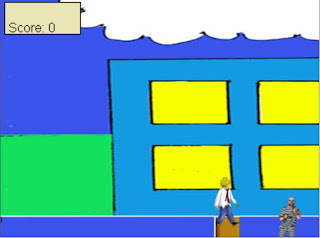Platform games initially appeared at the beginning of the 1980s, when many video game genres were just beginning to form. Because of the technical limitations of the day, early examples were confined to a static playing field, generally viewed in profile. While platformers offered a new kind of game play, they still borrowed from earlier games. Frogs, an arcade game released by Gremlin in 1978, was the first game to feature a jumping character, making it the genre's earliest ancestor. Players could not control the direction of the jump however, nor was it possible to jump between different platforms, only to fall off either side of the one platform on screen.
Space Panic, a 1980 arcade release, is sometimes credited as the first platform game, but the distinction is contentious, since the player had no ability to jump, swing, or bounce, or fall, and as such, does not satisfy most modern definitions of the genre. However, it was clearly an influence on the genre, with game play centered on climbing ladders between different floors, a common element in many early platform games.
Donkey Kong, an arcade game created by Nintendo, released in July 1981, was the first game that allowed players to jump over obstacles and across gaps, making it the first true platformer. Donkey Kong had a limited amount of platforming in its first two screens, but its other two have a more pronounced platform jumping component. This game also introduced Mario, an icon of the genre. Donkey Kong was ported to many consoles and computers at the time, and the title helped to cement Nintendo's position as an important name internationally in the video game industry.
The following year, Donkey Kong had a sequel, Donkey Kong Jr.. The third game in the series was not a platformer, but it was succeeded by Mario Bros, a platform game that offered two-player simultaneous cooperative play. This title laid the groundwork for other popular two-player cooperative platformers, like Fairyland Story and Bubble Bobble, which, in turn, influenced many of the single-screen platformers that would follow.
Beginning in 1982, transitional games emerged that did not feature scrolling graphics but had levels that spanned several screens that could be traveled between. Pitfall!, released for the Atari 2600, featured broad, horizontally-extended levels. It became the best selling game on the system and was a breakthrough for the genre. Smurf: Rescue in Gargamel's Castle was released on the ColecoVision that same year, adding uneven terrain and scrolling pans between static screens. Manic Miner (1983) and its sequel Jet Set Willy (1984) continued this style of multi-screen levels on home computers. Later that same year Epyx released Impossible Mission, which further expanded on the exploration aspect and laid the groundwork for such games as Prince of Persia.
Like many of the gaming firsts mentioned in this article, the first platform game to use scrolling graphics came years before they were the trend. Jump Bug was a simple platform-shooter, developed by Alpha Denshi under contract for Hoei/Coreland and released to arcades in 1981, only five months after Donkey Kong. Players controlled a bouncing car and navigated it to jump on various platforms like buildings, clouds and hills. As part of a nascent genre, it was not strongly influenced by existing conventions, nor was it a major influence on games after it. In the years that followed, Jump Bug was largely forgotten, but it offered an early foreshadowing of what was to come, with uneven, independently suspended platforms and levels that scrolled both horizontally and vertically.
In August 1982, Taito released Jungle King. The title featured Tarzan (an unauthorized use of the character that would result in a lawsuit), with vine-swinging mechanics similar to those in Pitfall!. It also featured a scrolling jump and run sequences that had players hopping over obstacles. In many ways, the gameplay was more simplistic than Pitfall!, but the scrolling proved a compelling addition to the formula. This same year Irem released Moon Patrol, a shooter with light platform jumping elements. It was similar to Jump Bug, but the platforming was not nearly as well developed, consisting of little more than hopping over small obstacles.

















